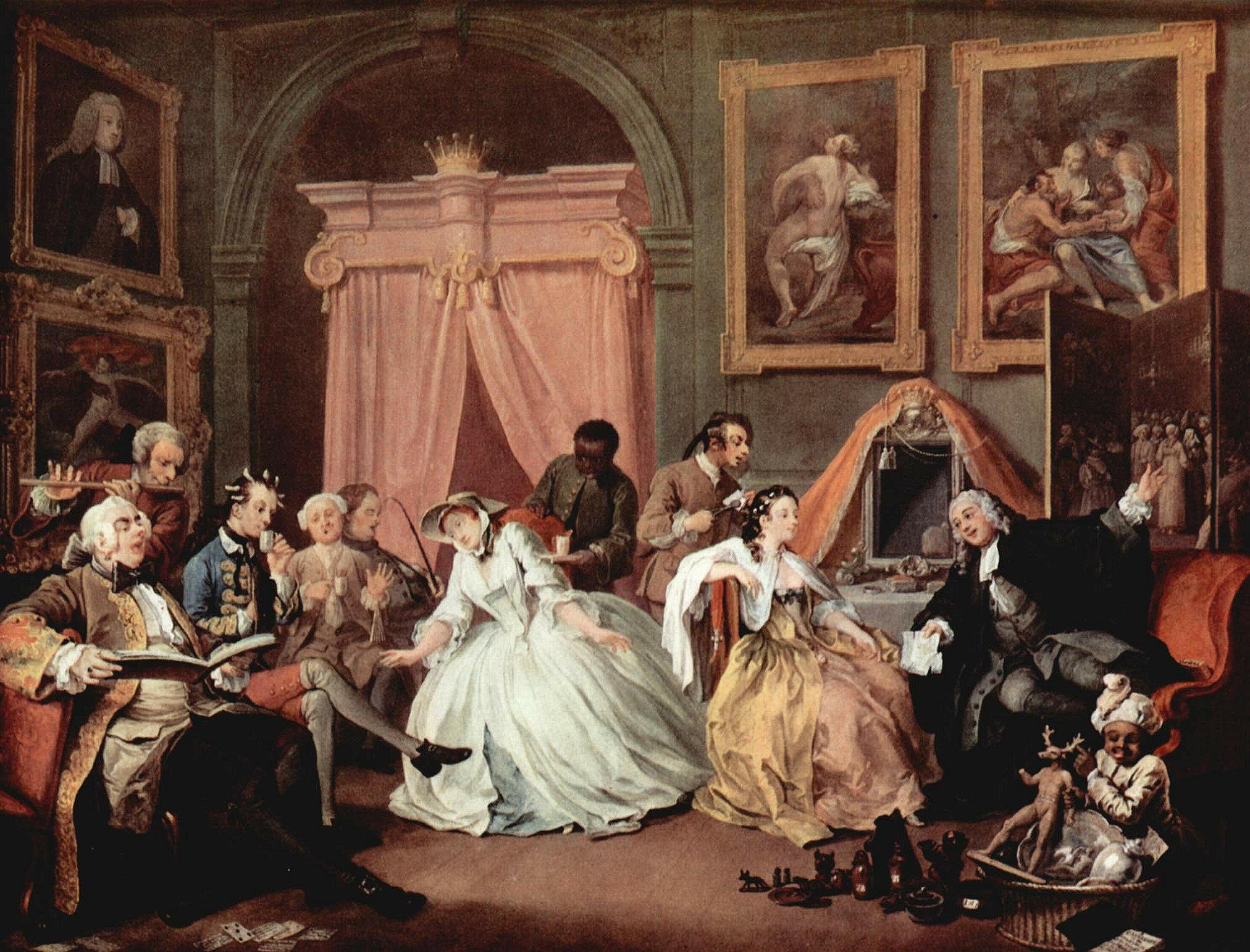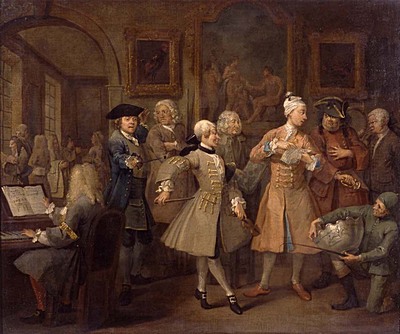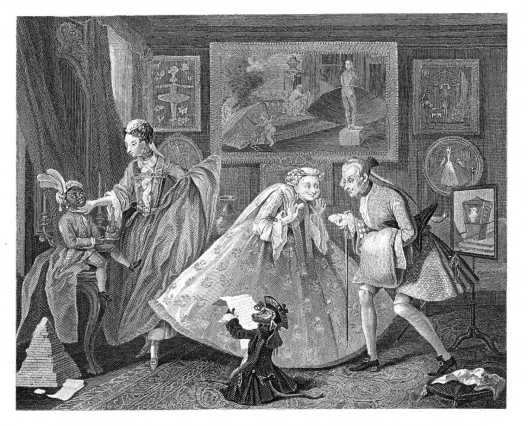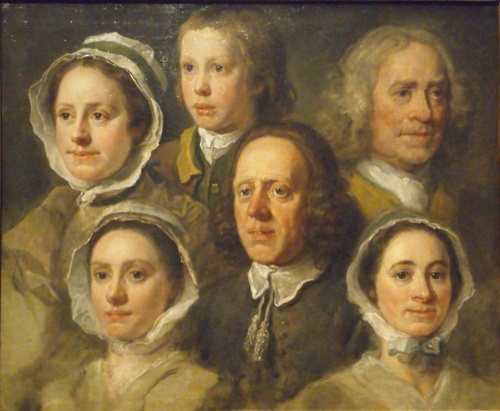Hogarth:
An Aid to Comparison
This is a page to show you the comparisons between Hogarth’s paintings of this time and what was going on in English fashion to the people and their clothing in this painting: James III
We’ve got here, examples of the full fronted skirts that feature so frequently in Hogarths images and the similarities between the men in Hogarth’s paintings and the men in James III. A lot of these examples date around the 1730-40’s.
The Images:
Hogarth – Marriage a la Mode Series – 1745
Details:
– We’ve popped this image in first because it is a prime example of the two costume styles we are comparing. In James III’s painting the men are also dressed with these large black cravats, the development of the coat into a slight cut-away and the edge braiding/embroidery and large cuffs.
– We also have here examples of stockings over the knee (see the man sipping tea).
– The style of wig with a large Black bow at the back, either on a pigtail or a bag (a style of Bag Wig).
– Compare the front gentleman singing with the man talking to the Blue Lady in the 2nd Close-up image and you can see the similarities. We know that it can seem like the 18th century doesn’t change much in style but this look if quite specific to only about 20-30 years, predate this and you have much straighter front jackets that could be worn closed and with a boxier cut to them, darker colours. Go forward and the cut-aways become much more extreme, the waist coats shrink and so do the cuffs. This black bow at the back of the neck on the wig is also quite specific to this period.
– The Countess (the lady in white) is sporting this full fronted skirt. The pleating comes all the way round the front on either the ‘Closed Robe’ or ‘Open Robe as featured here.
Mary Edwards – 1742 – Hogarth
Details:
– An example of a Closed Robe with a lot of Fullness in the front. Here is an example of that fullness beginning to be pushed more to the sides but it is still fairly central compared to some. Also the fabric is much heavier than what the later dresses are made of which accentuates this fashion for fullness.
– Here she wears baggy sleeves that end in a loose, possibly vaguely pleated Hem.
– CF seam.
– She is also wearing a mob cap/Pinner with short and wide lappets, a frill that flaps over the front decolletage of the dress and a form of Tucker that comes all the way down through the Buckle at the Front of the dress.
– Interstingly enough, she is actually wearing a cross, contradicting what we have just said about this not normally being worn. This is unusual though, mostly pearls or simpler necklaces being in fashion. Mary Edwards was ridiculed for being out of fashion though and is a point possibly needing to be taken into consideration when viewing the portraits of her.
Hogarth: Conquest of Mexico – 1732
Details:
– Being that much earlier than the above image you can see just how full these skirts could be and what the silhouette was.
– Gentleman nearest to us wears a Bag Wig with a black bow and this very popular light blue colour of his jacket. There is a very similar gentleman in Image no. and Image no. of the Close-up shots.
Hogarth – Rakes Progress – 1735
Details:
– Again, more examples or bag wigs, black bow cravats and a clearer example of the sprung out skirts of the men’s jackets. According to historians ( for example Iris Brooke) these skirts and pleats could even be held out by wire.
– There is also a man in Undress, wearing a banyan and a Turkish style cap.
– Its unclear in these images if the stockings are under or over although the more we look at the centre guy it does begin to appear as if he’s wearing them over his breeches.
– An example of a man wearing possibly ‘tucked in’ stocking is in image no. .
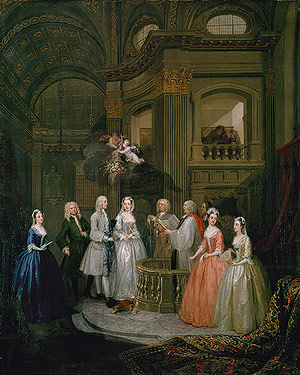 Hogarth – The Wedding of Stephen Beckingham and Mary Cox – c.1729
Hogarth – The Wedding of Stephen Beckingham and Mary Cox – c.1729
Details:
– This is another interesting and exciting image. Because it’s painted that much earlier you can clearly see the full fronted skirts and loose sleeves and the slight way they have been pinched into a cuff effect.
– Stephen Beckingham (the gentleman getting married) is that bit earlier also and therefore is a good example of the coats looking that little bit more boxier, baggier and squarer.
– The Wigs featured in this painting are long and are similar to the ones in Image no.4 and the man bending down to get his hat in image no. .
– The women wear their lappets long and narrow and are of the same ilk that Watteau paints folded up onto the caps.
Hogarth – A Taste of the High Life – no later than 1743
Details:
– Commisioned by Mary Edwards, this cartoon satirizes some of the fashions of the day. Here you have an example of a Wide pannier dress in what looks like Robe a la Francais. This is a bit confusing actually. The large piece of fabric on her back does seem to match her dress fabric but then it seems to run into these shawl like bits hanging down at her front. It could be possible that they are loose robings but we’re not seen anything like this before.
– The gentleman wears a long and thin pigtail wig with a bow and has the pleated and swinging out skirts that we have been looking at.
– He also wears his stockings over his knee. Which is quite interesting as Hogarth is depicting the apparant followers of fashion and this seems quite well on into the years when tucked in stockings were more favoured. Possibly it could have been a short lived fashion of echoing this older style or just that this was a grey area of stockings being ‘tucked in’ or ‘folded over’ and could be down to personal choice.
– He also has deep cuffs where as the Centre Front lady seems to be sporting slightly smaller versions.
Hogarth – Servants – c.1750
Details:
– The reason why we’ve included this image here is because of the side glance we get of a Mob cap (top left). All three female servants seem to wearing them and all with fairly short lappets done up under the chin. top left lady wears a double frilled mob cap with green ribbon around the crown – a Pinner wouldn’t have this kind of deep crown. But given a front view this lady may too have a central indent which was possibly what were identifying Pinners with.
–
–

